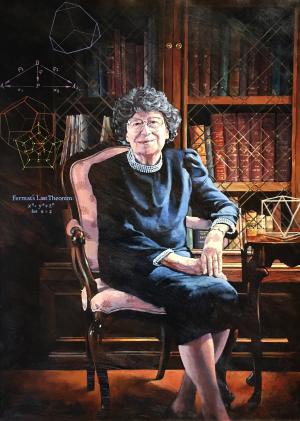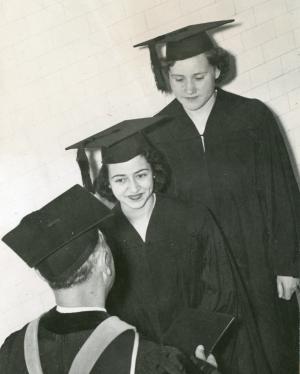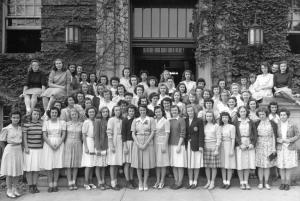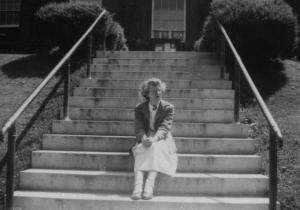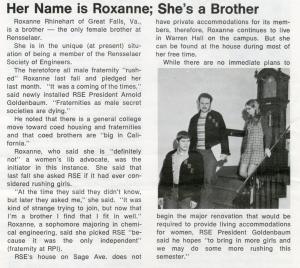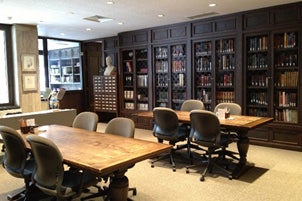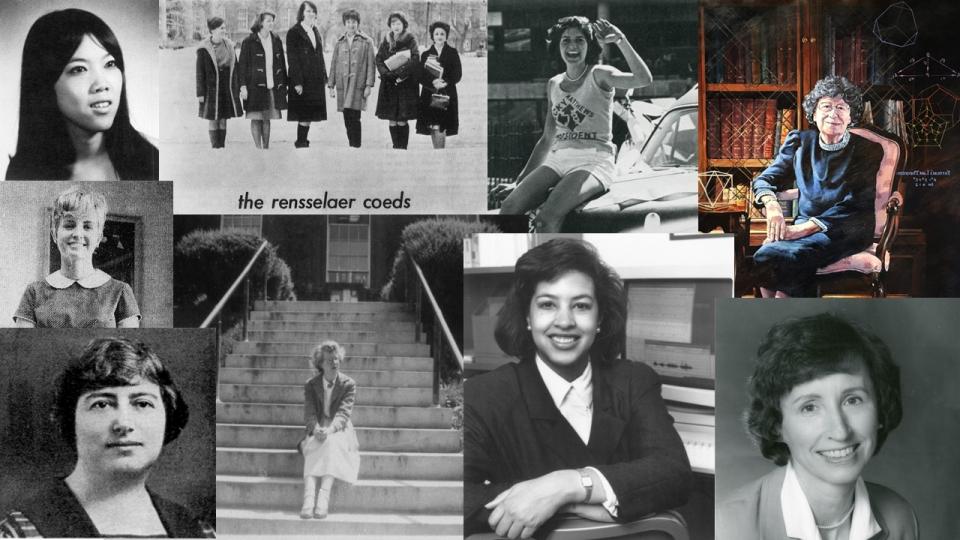
For the month of March, in honor of Women's history, the Institute Archives and Special Collections celebrates the history of women at Rensselaer. This post highlights Those Who Led the Way and covers 1834 through the 1980's. At the end of March we’ll highlight the countless achievements of women (faculty, staff, students, alumnae) from the 1900s to the present.
Eaton & Women’s Education | Amos Eaton, one of Rensselaer’s most renowned early professors and a staunch advocate for the education of women. In 1834, while a professor at the Rensselaer School, Eaton enrolled a class of eight young women in a special mathematics course to show that they could advance beyond "the speculative geometry and algebra as generally practiced in female seminaries." The women were not taught at the Rensselaer School, instead they were taught at Walnut Grove under the direction of Laura Johnson. In February of 1835, Eaton wrote to the Rensselaer School’s Board of Examiners to explain the progress and accomplishments of the women and suggested admitting women to courses at Rensselaer. The Examiners commended Eaton for his mathematical teaching but did not address the education of women as students at Rensselaer. The eight young ladies who participated in Eaton's experiment continued their education at the Troy Female Seminary (now Emma Willard School).
The First Woman to Apply | Elizabeth R. Buswell was the first woman to formally apply for admission to Rensselaer in 1873. An October 4, 1873 newspaper clipping stated that Prof. Drowne would implore Miss Buswell not to pursue her application to Rensselaer. This was supported by the statement that, "The institute makes no discrimination in regard to sex, but the professor believes that Miss Buswell's position as the only lady student would not be pleasant." It further explains that if Miss Buswell were to apply with three or four other women, then they would likely be welcomed. Miss Buswell decided not to pursue her application.
Renshaw and the Vote for Women | In 1918 Rensselaer was losing male faculty and students to WWI. Alfred Renshaw, a trustee of Rensselaer and brother-in-law to President Ricketts, made a motion at the December 5 meeting of the trustees to allow women to enroll at Rensselaer. Renshaw’s vote not only lost, but was followed by trustee Henry W. Hodge's motion that, "Resolved, that at the present time it is not advisable to allow the admission of women students." The vote for this motion was unanimously 'yea', apart from Renshaw's vote.
The First Women to Teach at Rensselaer | On the flip side, Rensselaer appointed Miss Hazel Brennan as an assistant instructor in Chemistry in 1918, making her the first woman to teach at Rensselaer. Then in 1919, Marie De Pierpont was hired as an instructor in French. She was later named full professor and head of the language department in 1928. De Pierpont was the first woman to hold a full professorship at Rensselaer, a position that she held until her departure in 1932. In 1943, Herta Leng was hired as an instructor in the Physics Department. Two years later, she was named assistant professor and became a full professor 23 years later in 1966, making her the second woman to gain full professorship at Rensselaer, and taught at Rensselaer until 1968. When Edith Luchins was hired as an associate professor in the Mathematics Department in 1962, there were less than 25 female students and faculty at Rensselaer. Luchins was promoted to full Professor in 1970 and stayed at Rensselaer until her retirement in 1992. Luchins was the first woman elected to chair Rensselaer’s Faculty Council, and she was the third woman to gain full professorship at Rensselaer and the first one to stay at RPI for an extended amount of time after gaining the professorship. Luchins also became the first woman to win the Outstanding Faculty Award in 1991. In January 1994, she became the first woman faculty member at Rensselaer to receive a commissioned portrait which hangs in Folsom Library!
The First Two Women to Graduate from Rensselaer | In 1942 the Polytechnic headline read "Rensselaer ~ Breaks Long Standing Tradition; Opens Registration to Women for the First Time." The article goes on to explain that Rensselaer would accept female students to replace the men who had been called to serve in WWII. The first class included Camilla (Trent) Cluett in Architecture, Elizabeth English in Biology, Lois Graham in Mechanical Engineering, Helen Ketchum in Architecture, and Mary Ellen Rathbun in Metallurgical Engineering. Of these first five women admitted to Rensselaer, Lois Graham and Mary Ellen Rathbun became the first to graduate on April 22, 1945. Additionally, in 1944 Lois Graham had been the first woman inducted into Pi Tau Sigma, the Mechanical Engineering Honor Society.
The Curtiss Wright Cadettes | During WWII the demand for women to replace men drafted for the war effort continued to increase. Women were hiredto fill the engineering and technician jobs left behind by the men, but there were not enough women with technical training. To address this shortage, many companies created programs to recruit women into crash courses to turn them into engineering aides for the war. The Curtiss-Wright airplane company created one of these programs in 1942. The Cadettes came to Rensselaer on February 12, 1943 and took part in a 44-week program that was broken into two 22-week semesters. The huge influx of women was a notable change on campus. The first women to be initiated into the RPI Players were 7 Curtiss-Wright Cadettes in the spring of 1943. Additionally, some of the Cadettes, "joined the depleted cheerleading squad," and supported the Rensselaer teams. The Cadettes left the school's campus on December 15, 1943, at the end of their 10-month program.
A Bit of a Lull | From the mid 1940s through the 1950s there was not much active recruitment of female students or faculty. As a result, between April 1947 and August 1963, 17 out of 54 graduating classes had no women graduates. Despite this, Antoinette A. Patti became the first woman to receive a Master's Degree from Rensselaer on February 1, 1947, in Chemistry, and Reva R. G. Servoss became the first woman to receive a Doctoral Degree from Rensselaer on June 11, 1954, in Chemistry. In reality, it was not until the 1960s, and 1970s in particular, that the administration began taking steps to promote Rensselaer's coeducational status. The administration also began taking steps to raise the number of women staff and faculty as well.
Employee Positions for Women at Rensselaer | Women held almost all secretarial and clerical positions at Rensselaer during the 1960s and 1970s. The introduction of new positions allowed women to be involved in more areas of campus life. In the fall of 1968, Vicki Doff was hired as the Women's Advisor and Affairs Coordinator. Doffs' appointment provided women students with their first official representation in the school's administration. Cindy Soja became the Coordinator of Women's Affairs and acted as Dean of Women Students in 1971. In 1986, Susan Clarke was hired as Vice President of Administration making her the first female vice president at RPI.
Sororities & Student “Firsts” | Sororities did not come to Rensselaer until 1976. Before this, a very small number of women joined fraternities. In the fall of 1970 Roxanne Rhinehart rushed the Rensselaer Society of Engineers and then became a brother in April 1971, making RSE the first co-ed fraternity at Rensselaer. Tau Epsilon Phi followed RSE's example by including 2 sophomore female brothers and 2 freshman female pledges in 1973. However, the nationals did not recognize these women as brothers. In the fall of 1975, Rebecca Kolb Segal and a few friends held an interest meeting for establishing a sorority at Rensselaer. After writing to national sororities and making formal presentations, Segal and her sisters decided to choose Phi Sigma Sigma as their sorority. They initiated 14 women on April 10, 1976 and Segal became the first president. After Phi Sigma Sigma was established at Rensselaer, several others followed suit. Additional student firsts continued to change the history of Rensselaer as well. Becky Matthews, from the class of 1978, was the first woman to be elected class president. In 1975 the women's basketball club became a varsity sport and was the first women's varsity sport at Rensselaer. Mary Garrity and Laura Tanski were elected as the first female Grand Marshall and President of the Union respectively in 1983.
More Firsts:
1943: Dr. Gertrude Fleming (of the Physics faculty at Russell Sage College) was the first woman physicist to conduct experiments in an RPI Physics lab.
1952: Catherine MacKay Hastings (RPI Class of 1953) was the first female athlete as a tennis player as well as the first female class officer.
1961: Nancy Gleason became the first woman to receive a Rensselaer scholarship
1966: The BAR-H dormitory opened at RPI with one wing dedicated as the women’s wing, which made it the first on-campus housing offered to women students.
1967: Carolyn Chin became the first woman elected as president of a major government body, the Independent Council. She also became the 1st woman inducted into The White Key Society.
1968: Carolyn Chin (RPI Class of 1969) was “tapped” by Phalanx, making her the first female invited into the society in its 56 year history.
1970: Jacqueline Ewing became the first woman to be a candidate for Grand Marshall at RPI.
1973: Carmen Lucci (RPI Class of 1975) Carmen Lucci became the first woman cadet at RPI and was the only female engineering major in the nation to receive a full Air Force scholarship.
1975: The Society of Women Engineers (SWE) was chartered at RPI and the Women’s Athletic Association was established.
1979: The Rensselaer Organization of Women (ROW) was created, but it only lasted 2 years.
1980: Ann Branscomb was the first woman appointed to the Board of Trustees.
1982: Sister Caroline Wales was appointed the first woman Chaplain at RPI.
Credits: Many of the details above regarding the history of women at Rensselaer can be credited to Brooke Hayden (RPI Class of 2017) for the incredible research she conducted in the Institute Archives during the Summer of 2016 - Spring 2017. Additionally, our research about the history of Rensselaer is ongoing. Please visit the Women at Rensselaer online exhibit for more information.
Please help us build our knowledge of the history of women at Rensselaer - feel free to comment below, we'd love to hear from our community!
